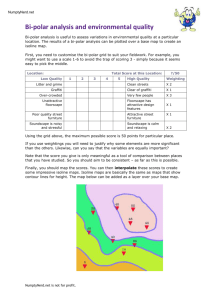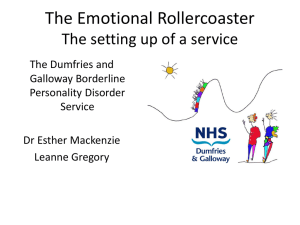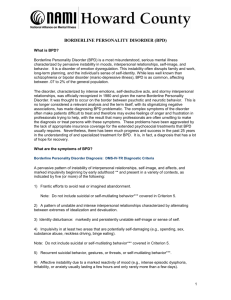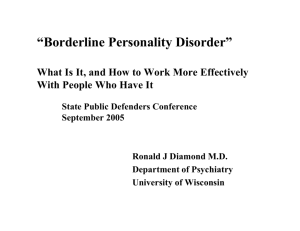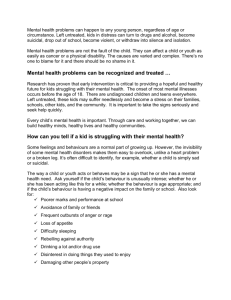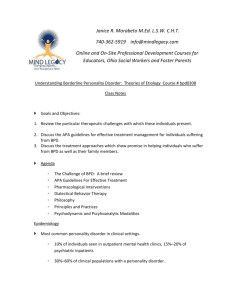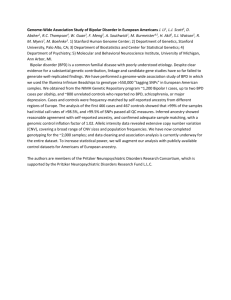Understanding Bi-Polar II
advertisement
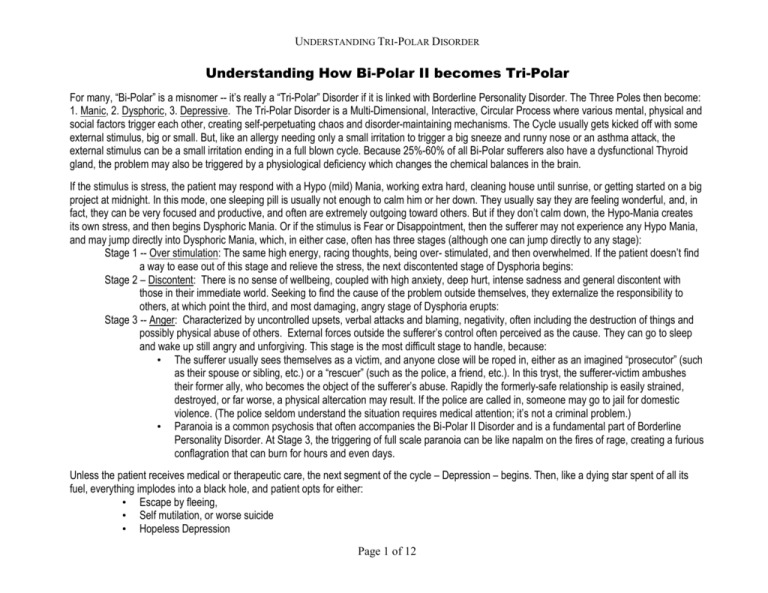
UNDERSTANDING TRI-POLAR DISORDER Understanding How Bi-Polar II becomes Tri-Polar For many, “Bi-Polar” is a misnomer -- it’s really a “Tri-Polar” Disorder if it is linked with Borderline Personality Disorder. The Three Poles then become: 1. Manic, 2. Dysphoric, 3. Depressive. The Tri-Polar Disorder is a Multi-Dimensional, Interactive, Circular Process where various mental, physical and social factors trigger each other, creating self-perpetuating chaos and disorder-maintaining mechanisms. The Cycle usually gets kicked off with some external stimulus, big or small. But, like an allergy needing only a small irritation to trigger a big sneeze and runny nose or an asthma attack, the external stimulus can be a small irritation ending in a full blown cycle. Because 25%-60% of all Bi-Polar sufferers also have a dysfunctional Thyroid gland, the problem may also be triggered by a physiological deficiency which changes the chemical balances in the brain. If the stimulus is stress, the patient may respond with a Hypo (mild) Mania, working extra hard, cleaning house until sunrise, or getting started on a big project at midnight. In this mode, one sleeping pill is usually not enough to calm him or her down. They usually say they are feeling wonderful, and, in fact, they can be very focused and productive, and often are extremely outgoing toward others. But if they don’t calm down, the Hypo-Mania creates its own stress, and then begins Dysphoric Mania. Or if the stimulus is Fear or Disappointment, then the sufferer may not experience any Hypo Mania, and may jump directly into Dysphoric Mania, which, in either case, often has three stages (although one can jump directly to any stage): Stage 1 -- Over stimulation: The same high energy, racing thoughts, being over- stimulated, and then overwhelmed. If the patient doesn’t find a way to ease out of this stage and relieve the stress, the next discontented stage of Dysphoria begins: Stage 2 – Discontent: There is no sense of wellbeing, coupled with high anxiety, deep hurt, intense sadness and general discontent with those in their immediate world. Seeking to find the cause of the problem outside themselves, they externalize the responsibility to others, at which point the third, and most damaging, angry stage of Dysphoria erupts: Stage 3 -- Anger: Characterized by uncontrolled upsets, verbal attacks and blaming, negativity, often including the destruction of things and possibly physical abuse of others. External forces outside the sufferer’s control often perceived as the cause. They can go to sleep and wake up still angry and unforgiving. This stage is the most difficult stage to handle, because: • The sufferer usually sees themselves as a victim, and anyone close will be roped in, either as an imagined “prosecutor” (such as their spouse or sibling, etc.) or a “rescuer” (such as the police, a friend, etc.). In this tryst, the sufferer-victim ambushes their former ally, who becomes the object of the sufferer’s abuse. Rapidly the formerly-safe relationship is easily strained, destroyed, or far worse, a physical altercation may result. If the police are called in, someone may go to jail for domestic violence. (The police seldom understand the situation requires medical attention; it’s not a criminal problem.) • Paranoia is a common psychosis that often accompanies the Bi-Polar II Disorder and is a fundamental part of Borderline Personality Disorder. At Stage 3, the triggering of full scale paranoia can be like napalm on the fires of rage, creating a furious conflagration that can burn for hours and even days. Unless the patient receives medical or therapeutic care, the next segment of the cycle – Depression – begins. Then, like a dying star spent of all its fuel, everything implodes into a black hole, and patient opts for either: • Escape by fleeing, • Self mutilation, or worse suicide • Hopeless Depression Page 1 of 12 UNDERSTANDING TRI-POLAR DISORDER Bi-Polar II + Borderline Personality Disorder Merry-Go-Round Bi-Polar, when combined with BPD becomes For many, it is really “Tri-Polar” – 1. Manic, 2. Dysphoric, 3. Depressive Stress Normalcy Disappointment Fear or Loss Hypo (Mild) Mania Illusion of Normalcy Dysphoric Mania Manic Dysphoric Depressive Externalized Angry Manic Depression Internalize d Hopeless Depression Suicidal Lack of Support Depression Depression Harmful Page 2 of 12 Paranoia, Perception of Harm UNDERSTANDING TRI-POLAR DISORDER To Better Understand Dysphoria What is Dysphoric Mania? Dysphoric Mania is the most enigmatic and vexing portion of the Tri-Polar cycle because it is a combination of both restless mania and depression occurring simultaneously and manifesting itself as uncontrolled anger. What Causes it? It is caused/induced by (or a combination of): • Stress, Loss (real or perceived), or • Poor/Dysfunctional Responses to a difficult situation, • Disappointment (failed or unrealistic expectations), or • Fear (real or perceived), or • Distrust or Betrayal (real or perceived), or • Impaired Health or Surgery or • Abnormal Thyroid Triggering Brain’s Chemistry Is Dysphoria something that only Bi-Polar People Experience? No, Dysphoria is a normal problem for anyone who has experienced frustration, disappointment, or crushed expectations. However, most people have coping mechanisms that enable them to learn, adapt, and adjust to the disappointment. Dysphoria is symptomatic of Borderline Personality Disorder. What is difficult in the Tri-Polar sufferer is that they lack some of these coping and adaptive abilities, because at the time they experience dysphoria their brain chemistry has changed. Their mental and physical state becomes significantly altered, and they experience a dramatically different reality from that which the normal person is experiencing. What happens when the brain chemistry changes? The patient experiences increased anticipation of harm and/or perceives the disappointment or loss is caused by something outside their control, which then produces reactive, angry behavior, instead of problem solving or acceptance of responsibility that is normal for well-adjusted people. Page 3 of 12 This anger and striking out in an accusatory manner explodes upon the sufferer’s social network, such as their spouse, family, friends, and co-workers. The adverse reactions of those people close to the patient, combined with the impaired mental and physical conditions of the patient, cause the circle to restart and rekindle. Then, if the perception of harm or loss (fear) is undiminished, the Stress Response Systems become overloaded (for example, (patients say: “I’m blowing my fuses”). There is greater activity in the Hypothalamic-Pituitary-Adrenal Axis (causing even more chemical imbalance) and the heart rate may change significantly. Continued use of these pathways means the brain circuits tend to use the dysfunctional path more easily, thus making the problem more likely to reoccur. For the patient, these physical changes in both the brain and the body then cause: more stress (often augmented by hypochondria) more anger (often augmented by others reacting with anger and argument) more vigilant arousal & fear (often augmented by paranoia) more focused attention on the negative (especially blaming others) increased harm avoidance (fleeing or sometimes suicide) increased introspection (self blame) decreased exploration of the realities in the environment (evidence) decreased responsiveness or rejection of external stimuli (e.g. rational thinking, caring by others, etc) decreased appetite for food and decreased sexual appetite Cycle continues until the Patient becomes totally exhausted, opts to exit, or receives the right support or medication UNDERSTANDING TRI-POLAR DISORDER How Mal-Adaptive Dysphoria Destroys Relationships While everyone suffers from Dysphoria at some time when things went wrong, the BPD sufferer has developed dysfunctional coping skills, or Mal-Adaptive Dysphoria ("MAD"). This is one of the most vexing problems to encounter. What's worse, the BPD sufferer does not know their perceptions of their world are turned upside down and inside out; and any attempt to convince them is only regarded as manipulation. When a their non-BPD mate tries to reorder the BPD's world, the BPD sufferer becomes confused with contradictory perceptions, sees their mate as a manipulator, and tries to re-manipulate their world back to the distorted view. This, in turn, makes their mate feel like the BPD sufferer is nothing but a grand manipulator. After a while, the non-BPD mate begins to question their own view of reality. Nothing seems to compute anymore. What ‘s real? What’s imagined? The non-BPD can eventually become confused, despondent, dysphoric, and angry with the fast accumulating stresses of living with a BPD mate. Because logic is totally thrown away in the "MAD" zone, the three pillars of any good relationship -- Love, Trust, and Belief in the value of the mate -- are usually irreparably destroyed. Love: For most people, if they want to be loved, they know that the best way to get love is to give a little love or be a little loveable. When a BPD person is in the MAD zone, they become angry and hypercritical about everything, pushing their mate way, rejecting attempts at love. Responding to this rejection the BPD's mate becomes disillusioned, or may walk (or storm) away from the poison, and, at worst, gets angry too. Any of these responses just reinforces the MAD view of the world in the BPD, thus deepening the cycle and setting the stage for the next breakdown, which is inevitably worse because of what preceded. Page 4 of 12 Trust: The foundation of all cooperation is trust. When in the MAD zone, the BPD person is both paranoid and angry. Because of their heightened feelings, their feelings become their reality, and thus the only thing that is true is what they "feel." Thus reality has to conform to distorted emotions, resulting in distorted reality, false accusations, and suspicions. The mate of a BPD typically responds first by trying to present valid, concrete, reality based evidence, which is rejected out of hand. Trust has been destroyed at this point. Then the BPD mate quickly learns not to discuss such matters, which just end up in a fight, defensiveness, confusion, and chaos. But, by not sharing information and discussing matters jointly, the seeds are sown for the next crash in trust, and the BPD's MAD view of the world is further distorted. Belief in the Value of the Mate: Valuing a mate is an essential ingredient to a long, healthy relationship. Healthy partners have a positive view of their future together, a balanced view of the positives and negatives of their past, and tend to try to make the present moment filled with happiness and joy. For those BPDs in the MAD zone, the world is a historic garbage dump of horrible failures, past transgressions, and lack of love. Everything in the present moment is a confused and angry concoction of hurt, criticism, blame, resentment, rage, twisted realities, and suspicion; which creates a frightening view of the relationship, and a thorough collapse in any belief that a future with their mate will produce joy, happiness, or success. Once this critical third pillar -- the belief structure -- is shattered, the last hope for survival of the relationship is left to the psychiatric profession (which might help) or lawyers, and/or the police, who are totally oblivious to the bizarre realities of BPD. UNDERSTANDING TRI-POLAR DISORDER Map of BiPolar II & BPD Cycles RAPID CYCLERs can go through this cycle at least once per month or even more frequently Euphoric (Hyper) Mania Present only in BiPolar I • • • • • Associated Psychosis (Sandra does not have Hallucinations or Delusions) [Psychosis is when thinking becomes disorganized, resulting in very poor judgment, often accompanied by intense fear or anxiety. In this state, the ability to reason is completely lost] Heightened Self Esteem Grandiosity Urge to be Outgoing, Gregarious Extremely Poor Judgment Hypo (Mild) Mania Massive Spending Sprees • • • • • Illusion of Normalcy Normalcy (Temporary Exit to Normalcy Condition) Feeling Great Dysphoric Mania Very Gregarious • High Energy, Racing Thoughts, OverHighly Productiv stimulated, Overwhelmed Needs Less Sleep • Problems Concentrating, Staying Focused (beneath veneer lurks • No Sense of Wellbeing, Sadness, Sorrow, irritability, dejected but trying Discontent, Distrust to look cheerful) • Pervasive Mood of Anxiety, Despair • Negativity Dysphoric Manic-Depression The energy of Mania, combined with the viewpoint of Depression accelerated by Paranoia Depression Internalized Hopelessness • Sadness, Hurt, • Unhappiness, Weepy, Clingy • Irritability • Sleep Disturbances • Loss of Self Esteem Flee Escape Intense Externalized Anger • Uncontrolled Anger & Blame • Unreasonableness, Demanding, Scolding • Fighting, Meanness, & Vindictiveness • Damage & Violence Against Things • Violence Against Other People or Motivation • Negative/Pessimistic Thinking Self Harm • Self Inflicted Wounding Suicide Page 5 of 12 • Borderline Personality Disorder Splitting Anger & Rage Abandonment Unstable Self Image Impulsiveness Suicidal & Self Mutilation Dysphoria, Depression Disassociation Control Issues Lack of Object Contancy Interpersonal Sensitivity Situational Competence Narcissistic Demands Manipulation High-Low Functioning Acting In, Acting Out • Paranoia Profound Distrust Belief Something is happening which isn’t Unfounded Fear of Harm Unfounded Assumptions Hypochondria Fear of Abandonment Highly Suspicious UNDERSTANDING TRI-POLAR DISORDER TRAPS General Treatment Proper Medication Meditation, Yoga Herbals, No Caffeine Exercise, Proper Diet Understanding & Compassion • Regular Sleep • Christianity • No Arguing/Fighting Bi-Polar II plus BPD Rapid Cycling • Caught in Content • Logical Response • Reactive Response • Arguing • • • • • Conditions, Triggers, Symptoms, & Responses RELEASE “This is Bi-Polar Disorder Talking. I don’t have conversations with Bi-Polar, I talk with my wife” Responses No Business Discussion After 8:00 pm Bedroom is only for Loving & Sleeping Stay On Time Symptoms Reduce Clutter Wide Awake @ Midnight Problems Concentrating Keep House Immaculate Overwhelmed Christ Says Forgive House Cleaning @ 2 am Anxiety Let Go of the Past Triggers Reframe the Past Unforgiveness Over- stimulated Focus on the Moment Unfulfilled Expectation Focus on Past Disappointment Travel & Time Change Plan the Future Illusion of or Loss Negativity Unrealistic Goals Condition Find/Say Fear Normalcy Hypo(Mild) Dysphoric Stress Something Good Irritation Mania Mania Fear of Focus on Trust Normalcy Abandonment Builders Distrust Internalized Dysphoric Declare a Bi-Polar Low Self Esteem Manic Depression Poor Health Blame Fear of Breakdown or Surgery Hyper-Critical Weepy, Clingy Abandonment Depression Anger is Not Perception of Harm Not Loved an Option Lack of Support Anger, Rage Paranoia Irritable Walk Away for Vindictive Hug & Hold 20 Min or Less Hopelessness Someone’s Trying to Get Me Despair Escape Be Compassionate Don’t Hold & Hug Destroy Things Listen, Understand, Suicidal Talk of Hit People Destruction is Not Death Let Her Know She is Loved General Symptoms Let Go, an Option Call • All or Nothing Call Talk Her Back Violence is Not 911 (black & white) Doctor an Option Thinking • Unrealistic, Illogical, Page 6 of 12 Unbalanced • Anxiety Ridden Racing Thoughts UNDERSTANDING TRI-POLAR DISORDER The Interactions of the Three Wheels of the Enigma Machine Stress Disappointment Fear or Loss Disappointment Fear or Loss Hypo (Mild) Mania Normalcy Stress Illusion of Normalcy Dysphoric Mania Mania Depression Externalized Angry Manic Depression Internalized Hopeless Depression Suicidal Depression Lack of Support Depression Paranoia, Perception of Harm Disappointment Fear or Loss Harmful Overactive Thyroid Limits of Effective BiPolar Medication Underactive Thyroid Page 7 of 12 UNDERSTANDING TRI-POLAR DISORDER THE ENIGMA MACHINE During the Second World War, the Germans invented a cryptographic device called the Enigma Machine. The first versions consisted of three interactive code wheels creating a myriad of ever-changing encrypted signals. This seemingly endless set of confounding permutations from the unique interaction of the three code wheels gave the English code breakers at Bletchley Park great consternation. Eventually the Allies got hold of a decoding machine from a sinking German submarine, and code-breakers were able to extrapolate the complex coding architecture. In many ways, we’ve been faced with our own human version of the enigma machine. The first wheel of the human enigma machine is the Bi-Polar cycle. When it interacts with the second wheel – the Borderline Personality Disorder – a set of highly volatile complications emerge. My hypothesis is that BiPolar and BPD’s interactions trigger and fuel each other. BiPolar is largely chemical, and BPD is mostly behavioral. BiPolar’s chemical imbalance can trigger a set of Borderline behaviors, which become so intense that it disrupts the brain chemical balance even further. Similarly, a set of perceptual triggers that launch a Borderline episode change the brain chemical imbalance and set off a series of Bi-Polar responses. For this reason, the medicinal prescriptions have had only marginal effect. This also may explain why she is a “rapid cycler” having three or more Bi-Polar incidents per month (or perhaps what we thought were Bi-Polar incidents were, more correctly, interactive Bi-Polar-Borderline incidents). The interaction of these two “wheels” is what might be called “Tri-Polar” disorder: Manic – Dysphoric – Depressive. (See set of visual pictures of this complexity on previous page) If this hypothesis is true, then any medications can only be effective if there is behavioral intervention as well to quell the BPD disruptions. Now comes the third wheel of the Enigma Machine: Thyroid Disease. According to research, anywhere from 25% to 60% of all those with Bi-Polar Disease also have thyroid problems. As the body’s second most important endocrinal gland, a malfunctioning thyroid can set into motion an endless stream of metabolic dysfunctions, including triggering imbalances in brain chemistry, thus igniting the Bi-Polar fuze. One patient had just been diagnosed with Toxic Multi-Nodular Goiter, which seemed to run in cycles of hyper, then hypo active. This cyclical irregularity was probably triggering the Bi-Polar attacks, sending this woman’s brain chemistry beyond the limits of what the medication was designed to regulate. Then the Bi-Polar attacks triggered a Borderline episode, resulting in a full blown suicidal incident. There is also a link between BPD and anti-thyroid antibodies which as yet to be fully explored. Ten days before this person’s last attempted suicide, she had been prescribed for medication to control a hyper-thyroid condition. The medication brought her thyroid activity down precipitously. Apparently (though not fully confirmed) she then went into a downward thyroid cycle towards hypo-thyroid, which then triggered a depressive bi-polar attack. Page 8 of 12 UNDERSTANDING TRI-POLAR DISORDER TRIPLE JEOPARDY Inheritance is one of the causes of the Tri-Polar problem. Coming from a Bi-Polar family creates its own vicious circle, because Bi-Polar parents can give their progeny double trouble: first, genetically inherited bipolar disorder and second, a dysfunctional and erratic family environment that induces Borderline Personality Disorder. Once set in motion, these two psychiatric maladies cascade down from one generation to the next. Either of the disorders are difficult enough independently, but together they self-generate a raging storm that feeds on itself. While BPD is largely a maladaptive behavioral response to a very tenuous and uncertain life condition, Bi-Polar is largely a chemical condition. But the behavioral power of a BPD episode is so intense as to trigger endocrinal chemical shifts in serotonin and adrenal levels, and perhaps thyroid and adrenal levels as well. No wonder suicide or self-damaging mutilation is the only way for some people to stop the storm. Jails are probably filled with sufferers or victims from this series of maladies. 30% of all psychiatric hospital admissions are from Borderline Personality Disorder. For those who are mates to BPD sufferers, domestic violence is frequent. But, to the consternation of the mate of a BPD sufferer, none of the typical anger management techniques works, and, tragically, most of those techniques actually produce the opposite effect, leading the non-BPD mate to feel totally hopeless, and perhaps crazy themselves. WHAT IT FEELS LIKE TO LIVE WITH A BI-POLAR/BPD SPOUSE – THE TESTIMONY OF A NON-BPD MATE Being in a Tri-Polar’s world is like being in Vietnam. You never know if the person with whom you live and sleep is your ally or your enemy. In a flash, things can go from normal -happy, and peaceful -- to explosive -- bullets, napalm, and bitter battle. For the non-BPD mate who survives this massacre, there is no glory, no hero's welcome, no sympathy, no thanks from either the BPD sufferer or the family (In fact, in the aftermath, there is usually blame, anger, and more grief.) If I told anyone what its like, I'd be blamed for being the cause of it. Because the Tri-Polar sufferer experiences a highly distorted view reality when they have an episode, that’s what's imprinted as a memory in their brain. (They do not remember the world as it really was, for the aphorism: “Perception is Reality” is totally true for the Tri-Polar. Therefore, there is no forgiveness, no apologies, and no sadness in the wake of a blow-out; just more anger, more blame, and more negativity, thus setting the foundation for the next incident. Hospitalization only makes things worse, because it confirms in the Tri-Polar sufferer’s mind that no one cares, everyone is against them, and more paranoia triggers more dysphoria, more anger, more hurt, and more emptiness. Living with a Tri-Polar means you can be instantaneously engulfed and consumed into an obsessively bizarre Lilliputian Page 9 of 12 UNDERSTANDING TRI-POLAR DISORDER world, one of explosive self-generated storms that will be whipped up into a frenzied and bloodied battleground. The simplest mistake, and all the sudden, I'm trapped in her little world where whispers become raging typhoons, dampness becomes a torrential flood, and minor irritants become nuclear holocaust. One probably wonders what causes the rages, the anger, the blame, and all the swirling sea of torment. The answer is not simple, but it is clear there are triggers everywhere, complex, and interrelated. If this was chemistry, the Borderline “molecule” would be compounds composed of many elements, each that can react violently to some stimulus. ********************************************* Triggers can be: perceived abandonment mistrust dysphoria fear or loss bruised self-image perceived lack of support perceived lack of love anxiety loneliness hurt feelings ambiguity or uncertainty sense of lack of control inattention by others lack of sleep stress ************************************************ Because there are a myriad of triggers, life is like a minefield -- the Borderline’s partner is constantly brushing against one of many unseen detonators. I can't have needs of my own for fear that those needs might trigger one of her detonators. I feel like I'm living on one of those movies where the villain has boobytrapped a bus or a plane and one little deviation from course or speed will blow the vehicle and all its passengers sky high. Or a real-life game of Dungeons and Dragons, where there’s a devil or monster behind every pillar and post. Every move of mine must be measured and calculated in advance. Life is like a chess game where you have to think several moves in advance for fear the other player will wipe you off the board. This makes living spontaneously very difficult. Joy, passion, or frivolity, while wondrous to most, becomes a high-risk game for the Borderline's mate. What the outside world finds difficult to understand is that the Borderline's exaggerated emotions launch a self-propelled anger. In response to her rage, I, as her mate, can either be silent, caring, or rational -- in each case totally self-controlled and non-combative -- and her wrath will nevertheless regenerate itself like an alien creature rising from the dead in a horror movie. If seen by a television camera, it would look like a one-sided fight – the thunderous explosion of “one hand clapping” – something most people have never experienced. I can state unequivocally it doesn't take two to fight. She can start a fight, continue to fight, and fuel her own selfperpetuating fight without instigation from me. It's rough living with someone who wakes up angry, it’s like starting the day with one foot in the grave, with two strikes against you, with a burning stick of dynamite in your hand, with a doomsday sentence the moment the new day is born. Page 10 of 12 UNDERSTANDING TRI-POLAR DISORDER This is what one Non-Borderline remarked about living with a Borderline spouse: their outbursts, concealing the disorder or masking it from the mainstream of life. Only those closest experience its wrath. Many of the techniques for anger-management don’t work. Walking away makes her angrier. Trying to hug her makes her angrier. Being compassionate and understanding makes her angrier. Logic doesn’t work. Active-Listening sometimes works. So often I feel hopeless and helpless to give her succor. This helpless-hopeless feeling is most distressful because it is so disempowering. And the constant state of ambiguity and uncertainty in which I have to live – never knowing from one moment to the next if I will be with Dr. Jekyll or Mrs. Hyde, with a lover or an enemy, with life or with death – generates its own dysphoria in me. My wife is a devout Christian, but when she enters the Borderline Zone, it's her version of the Twilight Zone; her Christianity is useless, worthless, and without impact. I can pick up the Bible and read Psalm 23 (or any other verse): "The Lord is my Shepard, I shall not want. He maketh me lie down in green pastures...." all to no avail -- for even the soothing passages of the Psalms make her angrier. I just learned of a workshop for partners of Borderlines. The headline read: – Are you coping with a loved one whose behavior you don't understand? – Are you frustrated, angry, or just feeling powerless? – Do others tell you to stop "enabling," to set boundaries or limits, to think of yourself? – Do you follow this advice yet see things getting worse instead of improving? – Ms. Porr will teach you a better way to help! Reading this headline can make a grown man cry. Her friends and family don’t have a clue what the problem is and what to do about it. They blame me; they tell her I’m no good, and still the problem lingers. Because BPD is mainly a behavioral disorder, it is somewhat controllable; she can hide or repress As a result of being in a battle ground -- at either a constant state of “high alert” or “under attack in combat,”-- I have experienced an inordinate of stress, putting me on edge, ever vigilant, and seldom trusting of the signals I receive from my world. Now, having completed some research and reading several books, at least I “know” what is happening to my wife and my world. Knowing makes it easier to understand, to be more sensitive, and to learn some coping mechanisms. With time, and with her receiving treatment, perhaps the situation will become livable. But I fear that some day I will be stressed, not in control, and not compassionate. And on that ignominious day she will attack me verbally with a barrage of abuse, I will not be understanding and tolerant, and will lash back with testosterone induced counter-attack of verbal abuse, causing her to escalate, and a real case of physical abuse will occur, with the police intervening. Then, try to explain this complex malady to a police officer, whose own stressed-out life is made a lot simpler by putting hand-cuffs on someone and carting them off to jail. Page 11 of 12 UNDERSTANDING TRI-POLAR DISORDER ________________________________________________________________________ The Overlap Between Borderline and Bipolar Disorders Why Many Borderlines are mis-diagnosed for Bi-Polar, or Bi-Polar is not seen as Tri-Polar From Dr. Phelps: http://www.psycheducation.org/depression/borderline.htm There is tremendous overlap in the symptom patterns of bipolar and borderline personality disorder (Borderline PD). The overlap reflects a basic problem with the concept of a "diagnosis" in the first place; for a brief essay on this topic, click here. Notice in the table below that almost every symptom is found in each column: Borderline PD (DSM list) Bipolar (broad view) Cognitive Cognitive Energy Energy Mood Mood Behavior Behavior unstable self transient paranoid ideation chronic emptiness abandonment fear impulsivity (sex, substances, self-harm) affective instability reactive mood episodic dysphoria irritability, intense anger anxiety suicide attempts (~10%) self-harm unstable self psychosis, esp. paranoid/grandiose _______________ _______________ impulsivity (spending, sex, substances, risk sports) affective instability "rejection hypersensitivity" dysphoria irritability, intense anger anxiety suicide attempts (~10%) self-harm? Page 12 of 12
